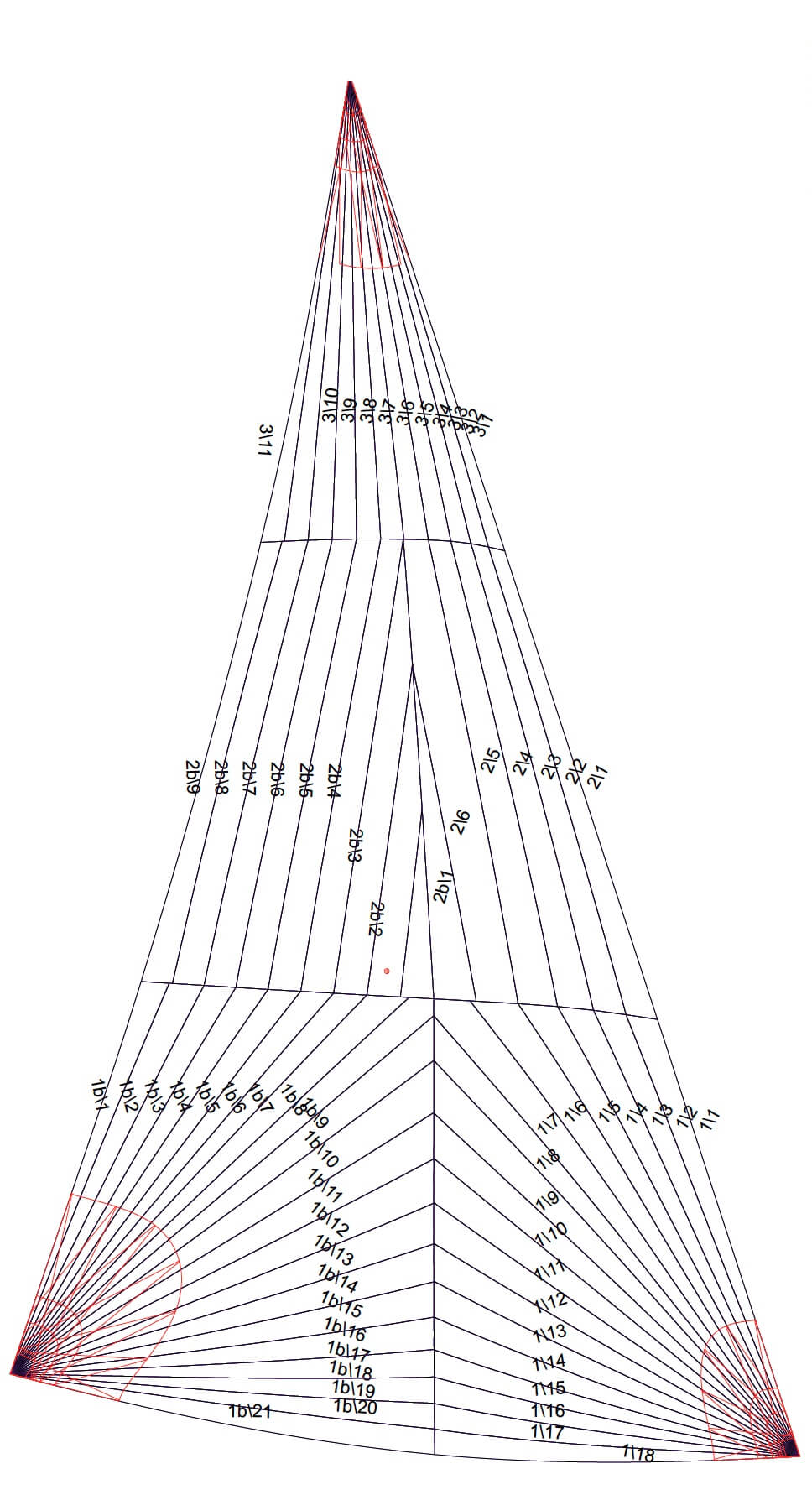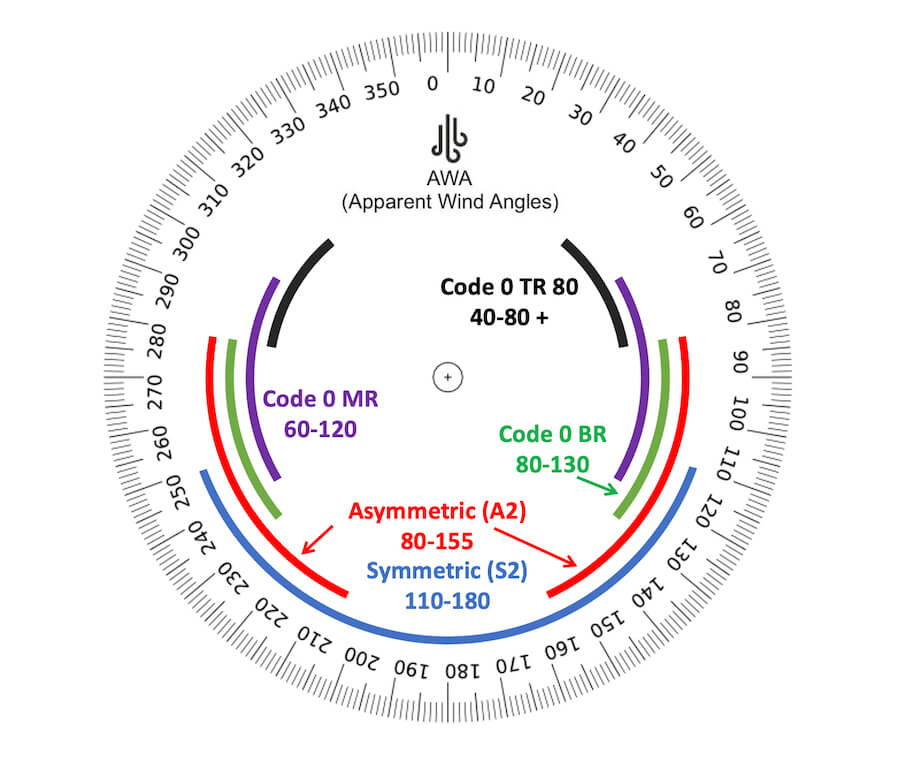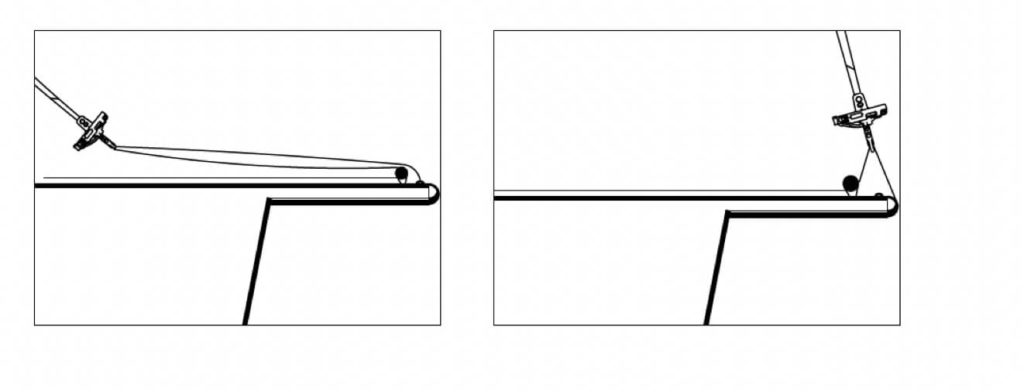
Who can benefit from a Code Zero (code 0) / Code Hybrid / Hybrid sail?
There is an infinite number of variations in code zero sails to cover a very wide range of AWA, playing on girth and draft, cloth style and furling system.
We can define, however, 3 broad situations where a Performance Code Zero sail is highly beneficial (if you are mainly cruising, see here for Cruising Code Zero):

1. Boats with non overlapping / self tacking jib – Code 0 target apparent wind angles AWA 40-100
On a boat with a non overlapping headsail, there is a significant power loss as soon as you bear away from closed haul. A flat, fairly narrow, furler-mounted Code Zero / code 0 can take you from almost closed haul to a hair below beam reach, where the downwind sail(s) will take over. Racers that must count this sail as a spinnaker will be constrained to a minimum width (75 % of foot), while sails designed for cruisers do not have that constraint and will be narrower. Look at our Code 0 TR concept for this kind of sail in our range
The iSpinnakers Code Zero TR – AWA (Apparent Wind Angle) range 40 – 100 *.
This primarily upwind sail is flatter and narrower than its sisters below, with a mid height girth of about 60%, +or- 5% for cruisers. Racers may be constrained by their rating system to minimum girth of 75%.
This sail has a nearly straight luff and is generally designed with a built-in antitorque rope, and to be used with our Seldén CX furlers.
It does require a lot of tension in the luff, and 2:1 purchase is recommended either at the halyard or at the tack line.
2. When looking for a true reacher (often called screecher) Code zero – target apparent wind angles AWA 60-120
This is the workhorse code zero for most situations:
- you have a spinnaker or deep gennaker for deep downwind / running,
and
- your genoa is not very big, leaving you with a power gap in broad to tight reaching angles.
This sail that will take over reaching duty from broad to tight reaching and bridge the gap between genoa/jib and full downwind sails. It is wider, and with a medium draft. In our range look for the Code Zero MR concept
The iSpinnakers Code Zero MR – AWA (Apparent Wind Angle) range 60 – 120 ( à 140 *. )
A popular concept, to complement your symmetrical spinnaker, or A2 style asymmetrical spinnaker. Perfect for a boat that has an overlapping genoa that will be used for tighter reaching angles. Mid height girth of 70% +or- 5%, medium draft for reaching power.
You can use either a top down (Seldén GX) or a bottom up furler (Seldén CX).
If you also have (or plan to get) a complementary A2 asymmetric / gennaker, ask us about the Seldén conversion CX/GX kit that lets you invest in a single furler unit that can be used with both sails. The CX mode will be used with the code Zero while the GX mode will be used with the A2 asymmetrical spinnaker.
3. When looking for a broad reaching sail – target apparent wind angles AWA 80-130
- The boat may have a symmetrical for running and is looking for a broad reaching sail, to bridge the gap with the genoa –
or
- you might have a very fast boat (catamaran or trimaran). With great boat speed, this code zero that can get as low as 130 degrees Apparent Wind Angle will be carried into true wind angles where slower boats would need to sail their asymmetric.
This is an even wider and deeper sail, at times getting closer to spinnakers. A top down furler may be used for this sail.
In our range, look for the code Zero BR concept.
Our Code Zero BR
AWA (Apparent Wind Angle) range 80 – 130
This sail is even wider with a mid girth of 80% +or- 5%, and draftier. It can get close to an A3 or A5 spinnaker and a top down furler (Seldén GX) is best.
* These apparent wind angles are optimum and provide maximum sail performance – the sails can of course be carried below those wind angles, and will keep powering the boat strongly. However outside of the optimal target range, the sail will not have the best possible performance (just like a 150% genoa can be carried effectively to 150 degrees or beyond– but will not pull as hard an A2 Asymmetric)
Cloth choice, furling, storage, etc.
Cloth choice
For all these sails, there are 3 main choices:
- The go-to solution is a Code Zero specific film with reinforcing fibers (polyester, aramid, etc.). We use primarily the CZ range from Dimension-Polyant, a film with reinforcing fibers in Polyester or Aramid. One side is reinforced by a rugged white or grey taffetas. There are also race oriented versions of the CZ cloth, with more exotic fibers, and no protective taffetas.
- For the MR and BR versions, a more economic but heavier solution is to use a heavy spinnaker cloth, such as Challenge NFS 94 (2.2 Oz) and NFS 144 (3.4 Oz). This is a great option for sails up to 50 sqm, beyond which weight becomes prohibitive. As an added benefit, the cloth is available in dark blue, red, black, and white, and not just grey and white.
- For high end racing applications, we can also build the sail in a string membrane.
Furling and sock
The deepest drafted versions of our Code Zero BR concept require a top down furler (Seldén GX).
All other versions can be used with a top down (Seldén GX) or bottom-up (Seldén CX) furler.
For a more economical solution, the MR and BR versions can also be used with a sock when built in spinnaker cloth. The sock is a proven and economic solution for retrieving these sails. It requires, however, a crew member on the foredeck for launching and retrieving the sail.
Anti Torque system
Top down furlers (GX) have their own antitorque rope as part of the furler.
Bottom up furlers (CX) have the anti torque system built into the sail, and we offer 2 options:
- The “classic” anti torque rope built into the sail luff (we use Vectran ropes)
- A cable-less version, where a series of carbon tapes glued strategically in a lens shape along the luff provide the anti torque function. (For sails built in spinnaker cloth, we add a luff area (10% of total sail area) made in Code Zero cloth to allow the application of the carbon tape cable-less system.)
The cable-less version is lighter and a joy to handle….It also requires less luff tension than a sail with a built in cable, and thus does not require a 2:1 purchase on the halyard or tack line.
A side note on the topic of furlers – An A2 Asymmetrical spinnaker (either custom or chose from our standard cut range) and Code Zero BR or MR are a great combination – we can provide you with a single furling system that will handle both sails using the Seldén CX/GX converter – As already mentioned above, this is a great solution that prevents you from having to purchase 2 separate furlers.
Storage
Code Zero sails cannot have a UV Band (unlike Genoa) and must be stored quickly when not in use, to avoid UV damage. A number of bag solutions are available, but we recommend a 2 meter Genoa-style long zipper bag, in which a furled sail can be flaked neatly. For sails used with a sock, a box bag or just a regular cinch bag are great.
CX luff tension
For the sails with a built-in AT rope, regular tension on the halyard is NOT enough. You need to install a 2:1 purchase system.
- At the Halyard you can use a dead end fitting and a special block:

Or
- At the tack you can use a special low friction shackle at the bottom of the furler, which also makes it easier to connect the furler from the fore deck if you have a bowsprit:
